Bike Tire Pressure – How Much Air In Bicycle Tires
Many cyclists pump up their tires only when they become noticeably soft.
They pump them up until they’re hard.
Is this the best way to do things?
Well, not really.
For a start, it helps if you know how much air pressure is in your bicycle tires .
Monitoring bike tire pressure helps you optimize your tires for comfort and speed.
It’ll also alert you to problems like slow punctures or faulty valves.
This article will help you decide how much air you should put in your tires.
Table of Contents

What Is Bike Tire Pressure And What Is PSI?
Bike tire pressure can be either measured in bars or PSI, but the latter is more common.
These units of measurement gauge air pressure inside the tire.
Air pressure gives the tire its shape and decides how much the tire flexes as you ride .
Since it uses pounds and inches, PSI is an imperial unit of measurement whereas the bar is a metric measurement.
One bar is equal to 100 kPa (kilopascal).
PSI (pounds per square inch) is the unit you’ll normally see written on the side of bike tires.
There will be a maximum PSI that you shouldn’t exceed if you want to avoid hazardous tire blowouts or tire deformation.
You may also see a maximum PSI on wheel rims, which contain the tire pressure.
Air pressure is directly related by Boyle’s Law to air volume.
The wider a tire is, the more air volume it has, and the lower PSI it needs to achieve the same “hardness”.
A lower PSI does not automatically make one tire softer than another (think of car tires).
Air volume is a vital concern if you ever think about using an automatic air pump at a gas station on your bike.
Those are designed for car tires with much greater air volume.
As such, they may explode a bike tire.
Why Is Bike Tire Pressure So Important?
Bike tire pressure affects three key aspects of cycling: safety, comfort and speed.
The PSI Safety Aspect
From a safety standpoint, it’s always useful to know if the PSI in your tires is too low or too high.
You can adjust PSI to suit various weather conditions.
Lowering pressure a little increases tire traction on icy roads, for example.
The weather has a direct effect on PSI .
If you pump your tires to the max and go riding in extreme heat, they may end up overinflated.
Braking heavily on rim brakes (e.g., on steep descents) also increases PSI.
There’s scope for disaster in certain situations.
Even in perfect riding conditions, a tire that is too soft and “squirmy” does not corner well and may risk the sidewall collapsing, potentially causing an accident.
PSI And Ride Comfort
Tire pressure directly affects ride comfort because a softer tire absorbs vibration from the riding surface.
Conversely, a tire that’s pumped up to a high PSI hits obstacles harder, causing discomfort as you ride.
One way that larger tires allow lower pressure is by their greater air volume and physical size.
That lets you run a slightly lower PSI without running much risk of pinch flats, at least on a road bike.
Of course, the chief benefit of tubeless tires is that you can run low tire pressures and the risk of punctures is inherently mitigated .
In theory, at least, any puncture is automatically sealed and you can continue on your ride.
The way a tire is made has a bearing on tire comfort and affects how much PSI you need.
With supple tires like tubulars or open tubulars, you are effectively riding on air.
The sidewalls are flexible and there are usually two layers of casing rather than three.
Supple tires flex more than vulcanized tires, even when their tire pressure is high .
And because they don’t have stiff sidewalls to help prop up your weight, it’s inadvisable to run them with a low PSI.
These tires give a plush ride regardless of pressure.
PSI And Speed
Tire pressure plays a role in your ability to ride quickly.
However, it’s impossible to calculate a precise optimum tire pressure unless the riding surface stays constant throughout the ride.
This is rarely the case.
On a smooth riding surface, a high tire pressure reduces the size of the tire’s contact patch and thus reduces rolling resistance.
This makes you faster.
However, a tire pumped to a high pressure on rough surfaces incurs “suspension losses”.
A nominal ideal tire pressure, then, takes the nature of riding surfaces into account throughout a whole ride.
Rider and bike weight also play a part, as this affects hysteresis losses and the likelihood of punctures.
You can take away something from this: maximum pressure is never the fastest choice on ordinary, variable roads or trails.
Try knocking a few PSI off for comfort and speed .
Bike Tire Pressure Chart And Pressure Recommendations
Tire pressure calculators and charts usually take your weight into account and the width of the tires you’re riding.
A common aim with these calculations is to create a 15% drop in tire height based on the metrics you supply.
The table below displays recommended pressures for a variety of tires at two rider (plus bike) weights.
It also shows how pressure drops with increased width and air volume.
Bike Tire Pressure Chart (PSI)
The PSI in the table assumes a 50/50 split between front and rear tires.
Some people prefer a 60/40 or 55/45 split, which means pumping the rear tire to a higher pressure than the front.
This accounts for the greater weight that the rear of the bicycle has to bear.
As well as rider and bike weight, any luggage or panniers you carry will increase recommended tire pressures.
Next, we’ll look at different types of bikes and their PSI requirements.
Tires on road bikes have traditionally been pumped up to very high pressures, dating back to when they were insanely skinny at 20mm.
Road cyclists for the most part ride on relatively smooth surfaces, so pressures can go a bit higher without causing discomfort.
The above being said, there has been a trend towards wider tires in the past few years, which can be nudged downwards a bit more in PSI.
Tubeless tires are also popular, and these afford even greater opportunity to run low pressures.
Maximum PSI in road tires can go to 140 PSI and above, though few would ride them at those pressures.
As mentioned in this article, optimum pressures are invariably lower than max .
Unless you’re riding on glass, that enhances speed as well as comfort.
Mountain Bikes
Mountain bikes have wider tires than road bikes, with widths that overlap in range with gravel and CX bikes.
All these bikes are ridden on rougher surfaces, which is why tubeless tires are common in off-road riding.
Many people run MTB tires at a low PSI relative to their max, though on rougher trails this invites the possibility of pinch flats or worse.
So, many riders use a higher PSI on bumpy terrain to avoid punctures or tire damage .
On smoother trails, you’ll gain a lot of comfort with a lower PSI, and if you pick the sweet spot you might get more speed as well.
As long as the trail isn’t too gnarly, this is a risk worth taking.
Hybrid bikes are intended to bridge the gap between road bikes and MTBs, so what about their tire pressures?
Well, a hybrid isn’t meant for rougher off-road stuff, but its tires are similarly sized to fatter road tires, gravel tires and narrower MTB tires.
If you run hybrid-bike tires at moderately low pressures on a smooth trail, you’ll gain those comfort benefits already discussed.
It probably won’t hurt your speed, either, as the lower pressure helps soak up the impedance of a trail.
What about a bike that was never designed for speed and always designed for comfort—the cruiser?
This is a bike that won’t be plowing through rough terrain.
Rather, you’ll be casually rolling along a beach or around leafy suburbs.
The balloon tires usually found on cruisers are designed to absorb shock or vibration.
Maximum pressure on modern balloon tires is in the region of 35-60 PSI.
As with all tires, you can run a lower PSI for extra comfort.
How To Check Your Tire Pressure
The simplest way to check tire pressure, albeit unsatisfactorily, is to give the tire a press with your thumb or finger.
It shouldn’t yield much.
Unless you have magic digits, this won’t tell you what the PSI is, but it’ll indicate whether the bike is rideable.
Video: The Human Pressure Gauge
You can look down on the tire from above, too.
It shouldn’t protrude much beyond the wheel rim if it’s properly inflated, though it’s very common for tires to do this slightly.
With standard butyl tubes in your tires, the amount of PSI lost from one day to the next is minimal.
Latex tubes, on the other hand, deflate a fair bit overnight.
The latter offer better ride quality, speed and puncture resistance, but they’re high-maintenance.
Tubeless tires lose air slowly as long as the sealant is doing its job and the valve works.
A better way by far to check tire pressure is to use a digital tire pressure gauge .
This will give you the tire pressure in the measurement unit of your choice.
And you’ll know if your bike is good to go or needs more air.
The downside of a pressure gauge is you have to keep removing it between sessions of pumping up the tire.
How To Inflate Your Bicycle Tire
There are a few simple steps to follow when pumping up a bike tire.
1. Choose A Bike Pump
When pumping up a tire at home, a floor pump with a built-in pressure gauge is ideal .
Outside, you can use a frame pump or a mini pump.
Make sure the pump you buy has the correct type of head for your wheel valves (Presta or Schrader).
2. Determine The PSI
Check the maximum PSI that should be written on the side of the tire.
Don’t exceed that when you go to pump air into the tire.
In reality, it’s hard to overinflate a high-pressure tire with smaller pumps, but keep the max PSI in mind.
3. Fix Pump Head To Valve
Now you need to attach the pump head (or chuck) to the tube or tire valve.
Take off any plastic cap.
With a Presta valve, you also have to unscrew the tip of the valve before it will let air in .
Depending on the pump you use, you’ll have to either screw the pump head on or push it on and secure it with a cam lever.
4. Inflate The Tire
Next, inflate the tire.
Aim for your desired PSI, taking into account the advice contained in this article.
When pumping up a tire, most of the air goes into the tire at the end of each pump stroke .
Be sure to push the handle up to the barrel.
5. Remove Pump
When you’ve pumped the tire up, remove the pump head from the valve vertically to avoid damaging the valve.
Do this briskly with a push-on pump head to avoid letting out air.
Tighten the valve head again if necessary and replace any cap if there was one.
Happy cycling!
- How often to replace bike tires?
- What are the best commuter bicycle tires
- What is the TPI in bike tires?
- Pumping a bike tire with a Presta valve adapter
- How to recycle bike tires
2 thoughts on “Bike Tire Pressure – How Much Air In Bicycle Tires”
Hello Glenn,
I recently managed to find a pair of NOS “Vintage” Michelin “Select” 630 x 28 (27 x 1-1/8-inch) “Gum Side Wall” tires for my 1970’s vintage road bicycle. These tires, though not low cost, are in exceptionally good condition: no sidewall cracking, bead damage or other faults! This pair of tires are also the first of this brand, model type AND of French manufacture (bought from a seller in France) I have ever owned where the side wall indicates “Inflate To 90 PSI (6.21 Bar)” rather than “Maximum Pressure 105 PSI”. I presume that 90 PSI IS the Maximum but all the previous versions, sourced in North America, I have owned were Maximum Pressure 105 PSI. I am 68 years old, 5 ‘ 6″ tall and 178 Lbs so what precise “gauge pumped” and “gauge measured” pressure would you recommend for these tires? Cheers! John G.
I could be wrong but perhaps the lower PSI recommendation because they’re 28mm and perhaps you had 25mm tyres previously?
I would stick within the manufacturer’s recommendation. I personally inflate 28mm tyres to around 80 PSI and only reinflate every week or so. It’s more comfortable with lower pressure and often the benefits of any faster speeds is negligible, or even non-existent with tyres inflated to the max.
Let us know how you go!
Leave a Comment Cancel reply
© 2024 BikePush. All Rights Reserved

- Stores Stores
Two-Minute Pump-Up Inflate your tires before every ride for more fun The easiest way to keep your bicycle running well is checking tire pressure before every ride. Properly inflated tires ride great, last long and resist flats. Plus, keeping the tires pumped prevents wheel damage should you hit a rock or pothole while riding. Bent wheels hinder braking and cost a pretty penny to repair. Fortunately, checking tire inflation is simple once you have the only tool required: a bicycle tire pump (don't use your local gas station pressure hose because it can overinflate and damage tires). Bike shops sell quality pumps (about $30 to $60) that are easy to use and safe. You might also have a battery-powered inflator for your car that will work if it reaches sufficient pressures. It's best if your pump fits both bicycle valves (Schrader and Presta; the shop will understand) and sports a built-in gauge, which makes it easy to get the pressure right. Pressure Check How do you know how much air to put in your tires? On most tires, the recommended pressure is printed on the sidewall. It's often written as a range, such as "90 to 115 psi (pounds per square inch)," which appears on some high-pressure road tires. You can experiment within this range to find what feels best for you. Less pressure offers a more comfortable ride and more air means less rolling resistance. Many cyclists opt for the best of both worlds and run 100 to 105 psi in their skinny road tires. Find the proper tire pressure range on your tire’s sidewall. If you're inflating 26-inch tires (common on comfort and off-road bikes), you may find that the pressure range is wider, say "35 to 60 psi." This is because these tires can be used on and off road. For the former, 60 psi is about right because it rolls optimally on pavement. Off road, however, 35 to 40 psi is much more appropriate because it absorbs the bumps, rocks and roots better and offers greater traction for control and handling. Air Time Inflating a tire is as simple as attaching the pump head to the valve and pumping. You'll need to unscrew and remove the valve caps first if your tubes have them. And, if you have Presta valves (they have a knurled tip and are also called "French" valves), you'll need to open the valve by unscrewing and depressing the tip just long enough to let a tiny amount of air out (remember to close it after pumping, too). Then, attach the pump and start stroking, stopping when the gauge shows that you've reached the recommended pressure. Repeat with the other tire. And you thought bicycling only exercised your legs!
- RWR Home Page
- Recent Posts
- Bike Reviews
Trek FX 2 Review: Ultimate Guide To The Fitness Hybrid Gravel Grinder
- by Riding With Ryan (Official)
My first bike from a legitimate bike shop was a Trek FX 2 Disc. There have been several changes over the years, almost all making this bike even better. If you are just getting into cycling and are interested in this Trek FX 2 review, be very careful. This bike will draw you into cycling, and soon you will start obsessing about saving grams, LYCRA, and Strava KOMs. Also, be sure to check out this 2022 Trek FX 3 review .
No need to worry about high prices with this bike. In other words, the Trek FX 2 is an awesome bike with a low price point, below $1,000. So what kind of bike is it, and who is it good for? These are both questions we will answer, and more, in this Trek FX 2 review. After that, you will want to call your bike shop to setup a test ride.
What Kind Of Bike Is The Trek FX 2?
The Trek FX 2 is a fitness hybrid bike. A hybrid bike is simply any bike that doesn’t fall into a specific category like road bike, mountain bike or cruiser. Fitness hybrids are bikes with similar geometry to an endurance road bike, but it will have flat handlebars instead of traditional road bike drop bars.
Fitness hybrid bikes can be ridden in the road, on light gravel, or a combination of the two. They make great bikes for commuting, as well as making an awesome gravel bike with flat bars. It really is a do-it all bike that’s good at everything, great at nothing.
For a long time I ran two different sets of wheels on my Trek FX 2. I had a set of wheels with 40mm gravel tires, and I replaced the stock 35mm tires for some slightly more aggressive 32mm road tires for the factory wheelset. Eventually tire upgrades were not enough and I started buying upgraded bikes. However, I love my Trek FX 2 so much I still own it today.
Who Is The Trek FX 2 Good For?
The Trek FX 2 is made for anyone looking for a high quality ride without sacrificing comfort. This bike is incredibly fast to anyone not already riding a road bike. With beefier tires its a capable endurance bike.
The Trek FX 2 has multiple rack and fender mounts for commuters, and plenty of storage add-ons available for tourers.
It’s not often a single bike fills the holes of so many different riding disciplines. This Trek FX 2 review may be the first bike review I’ve done that covers road biking, fitness, gravel, and recreational riding. All of which are extremely fun and comfortable on the FX 2. The only riding discipline the FX 2 isn’t good for is mountain biking.
Trek FX 2 Gravel Upgrades
One of the most popular questions in the bike shop these days is about gravel bikes. Its an awesome riding discipline that has exploded in popularity for good reason. An easy and affordable way to ride gravel is with the Trek FX 2.
The maximum tire size recommended by Trek for the FX 2 Disc model is a 38mm tire. I have first hand experience fitting 40mm tires on my Trek FX 2 without a single issue. Above all, you don’t want to risk your warranty. It’s best to stay within the specifications Trek recommends. Adding fenders restricts that maximum tire size to 35mm.
After the new tires the FX 2 is ready to shred your next gravel trail. Modifying grips and saddles, as well as adding clipless pedals are all recommendations I would make. Getting those accessories specifically for gravel riding will only enhance your riding experience.
Gravel Purists, or Gravel Snobs, will not appreciate your flat bar gravel bike. Gravel bikes have drop handlebars. Some forged bar ends hanging down should be the final touch to keep everyone happy. They will also give you some additional hand positions on longer rides.
Is the Trek FX 2 Worth It?
Yes, the 2022 Trek FX 2 Disc is certainly worth it’s $779.99 price tag. Save the extra $150 to afford the Trek FX 3 Disc. It comes with an upgraded group set and a carbon fork to eat up additional vibrations from the road. In other words, you can’t go wrong with any Trek FX model.
The 2022 Trek FX 2 Disc bikes come in two color options. Firstly, is Trek’s traditional Satin Lithium Gray that has been a color option every year on the FX model. The second color option is absolute fire. It is Satin Viper Red and it looks amazing.
I love the Viper Red for two reasons. Firstly, it makes the bike look great and look fast. Secondly, is the way the color stands out. Someone driving by is going to see this Viper Red bike. If they see you they are less likely to run you over. Which is, you know, a great thing!
If you are looking for a great way to transport your bikes read: Kuat NV 2.0 Review .
Trek FX 2 Disc vs Rim Brakes
Trek offers the FX 1 and 2 models in rim brake and disc brake versions. The FX 3 is disc brakes only. What exactly is the difference, and are disc brakes worth the upgrade? Lets dive into those details.
First, the difference between disc and rim brakes can be dramatic. Disc brakes provide better stopping power in all conditions. The Tour De France was won on rim brakes for over 100 years, but you can’t argue against disc brake stopping ability.
The only reason someone should consider rim brakes over disc brakes is if their budget requires it. Riding a rim brake bike is better than riding no bike at all. Also, many dry climates won’t notice much difference between disc and rim brakes. The differences are more noticeable in wet riding conditions.
In conclusion, if you aren’t sure which model of FX is best for you I’d recommend browsing through the details on Trek’s website. Also, you can read this 2022 Trek FX 3 review .
1 thought on “Trek FX 2 Review: Ultimate Guide To The Fitness Hybrid Gravel Grinder”
I just bought a Trek FX 2 Disc at Scheels Grand Forks, North Dakota on July 22nd, 2023. They installed cheap brake: RUSH bake system and Cheap tire 700x32c with no name on it into my bike. These components were not as specifications on sale list at Scheels Grand Forks, North Dakota. The bake system should be Tektro HD-R280 and the tires should be Bontrager H2 Comp, 700x35c. First, they said that they will replace the brake and the tire as the specifications on the sale list. Then they call me to come back to the store and told me they only change the tires to the Bontrager H2 Comp, and if I want to change the brake I have to pay for the labor. I really disappointed about this. To my experience, you should check out the component of the Trek bike before you buy it. If you don’t, maybe your Trek bike get a cheap component installed on it.
Leave a Reply Cancel reply
Your email address will not be published. Required fields are marked *
Save my name, email, and website in this browser for the next time I comment.
Privacy Overview

- Mountain Bikes
- Gravel Bikes
- Hybrid Bikes
- Electric Bikes
- Commuter Bikes
- Exercise Bikes
- Women’s Bikes
- Kids’ Bikes
- All Best Bike Brands
- Mountain Bike Brands
- Electric Bike Brands
- Bike Rack Brands
- Brand Review: Rad Power Bikes
- Brand Review: Ride1UP Bikes
Disclaimer: Bikexchange is reader-supported . We may earn an affiliate commission when you buy through the links on our site.
A Complete Bike Tire Pressure Guide
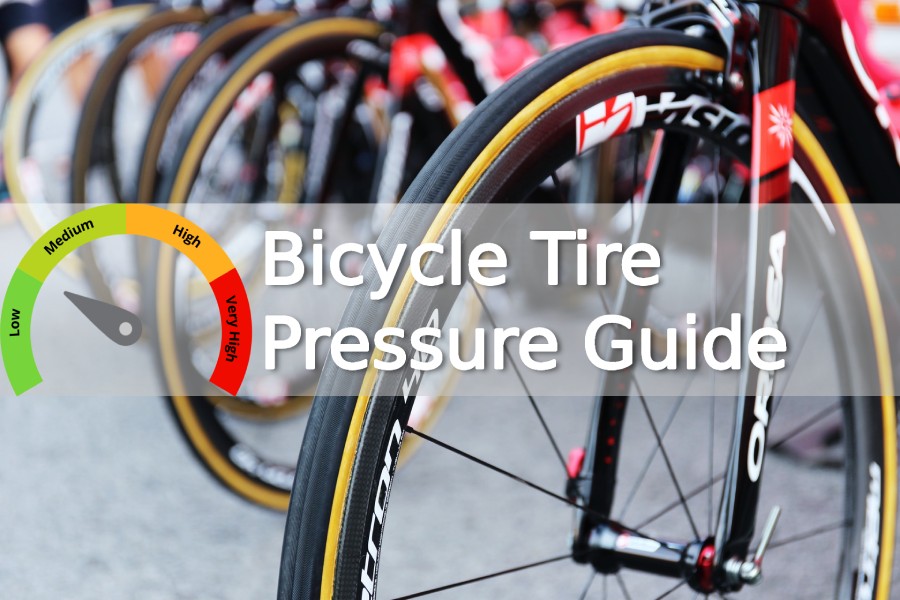
The question “what pressure should bike tires be?” is complex, but using an appropriate tire pressure is a fast, cost-free way to optimize your bike’s performance.
Bike tire pressure significantly influences how your bicycle feels and performs on the road or trail . Traction, speed, and comfort are the three areas affected the most.
The ideal bike tire air pressure attributes to a comfortable, fast, and controlled ride, whatever conditions arise. Conversely, inappropriate pressure increases fatigue and the risk of punctures and reduces speed.
The factors that determine appropriate tire pressure in any given situation include tire width, rider and bike weight, conditions and terrain, and whether the tires are tubeless or not .
This article will outline tire pressure ranges for different disciplines and the performance characteristics and essential points for measuring and managing pressure.
Things to Consider Before Delving Deeper
What is psi.
Pounds per square inch (psi) is the standard international tire pressure measurement. It indicates the level of pressure and stress (caused by air) in a pressurized tube such as a bike or car tire. The alternative metric measurement you may see is Bar.
- Higher psi (more pressure) = A harder, rigid tire
- Lower psi (less pressure) = A softer, malleable tire
Why bother with bike tire pressure?
As we touched on in the introduction, tire psi significantly influences traction, rolling speed, and comfort. Each tire has a psi range indicated by the manufacturer, which riders should stay within, but either side of this range will produce different results.
- Underinflated tires = Reduced speed, more prone to pinch flats, better grip and comfort
- Correctly inflated tires = Fast-rolling, sufficient grip, good shock absorption
- Overinflated tires = Sometimes slower, less grip and comfort
Running lower pressure increases bicycle rolling resistance and traction because more tire surface is in contact with the ground, absorbing more vibration from impacts. Low PSI is beneficial for wet weather, rough surfaces, or sharp cornering.
Running higher pressure decreases rolling resistance and traction, typically increasing speed (on smooth surfaces). However, more vibrations reach the rider, reducing comfort and increasing the rate of fatigue.
Know your valve type
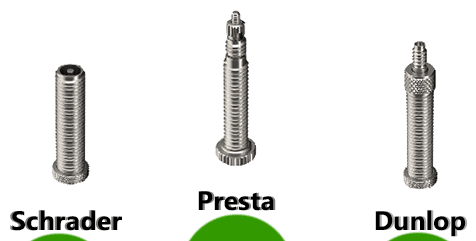
Know which valve type your bike has and use the correct pump.
Find out which valve type you have and choose the corresponding pump to operate it correctly.
- Schrader (cars) – Shorter, thick valve. Pump nozzle screws on to lock
- Presta – Tall and narrow. The top piece twists up, and then the pump nozzle is pressed firmly on
- Dunlop – Less common valve, tall and thick. Pump using a Schrader adapter
- Tubeless – Valve mounts to the rim. Connector varies

Presta vs Schrader Valves: What are the main differences between these valve types?
High-pressure vs. high volume bike pumps vs. co2 inflators.
High-pressure pumps – For high psi, narrow tires (road). They efficiently resist the pressure trying to escape the tube while pumping, so you can achieve a higher PSI.
High-volume pumps – For wide tires that require more air. They are easier to use but ineffective for high psi.
CO2 inflators – Small pressurized gas canisters rapidly inflate tires without pumping. These are an excellent tool for roadside repairs but inefficient for at-home use as CO2 leaks quickly.
More doesn’t always mean faster
Wider tires with lower air pressure are faster on rough surfaces than hard, high psi tires. The suspension gains of low psi reduce bouncing by absorbing the energy of impacts, allowing riders to maintain momentum. Hence, most professionals are transitioning from 23mm to 25mm or 28mm road tires.

Image: conti-tyres.co.uk
As you can see from the image above, a 28mm tire at 80 psi has the same rolling resistance as a 25mm tire at 90 psi or a 23mm tire at 120 psi. Therefore, a narrower tire pumped to crazy pressures is not necessarily faster, even though that’s what was considered to be true for a long time.
How often should I check my bike tire pressure?
High-pressure tires leak air faster than low-pressure ones. Given that, here are some averages:
- Road riders – Ideally check before each ride or at minimum once a week
- MTB riders – Check every one to two weeks
Check more often if you ride frequently.
Don’t trust the floor pump gauge
Most floor pump gauges measure the pressure inside the pump, not the tire. As a result, they give a good estimation but aren’t accurate.
A needle-style bike tire pressure gauge is the most precise measurement tool. That said, the gauge on a floor pump is adequate for most riders.
Recommended Tire Pressures by Bike Type
Various factors influence how much air pressure to use in bike tires, including tire width and diameter, bike weight, rider and cargo weight, weather conditions, terrain, and tubeless tires.
We will define broad ranges for individuals weighing 120 -200lb, adjust up or down for your weight, and the other variables. If you are outside that weight range, adjust further.
Each discipline has a range that maximizes the specific traits required for performance. A bike tire pressure calculator is the most accurate way to determine psi, but we’ve given some estimate ranges below.
Mountain Bike Tire Pressure
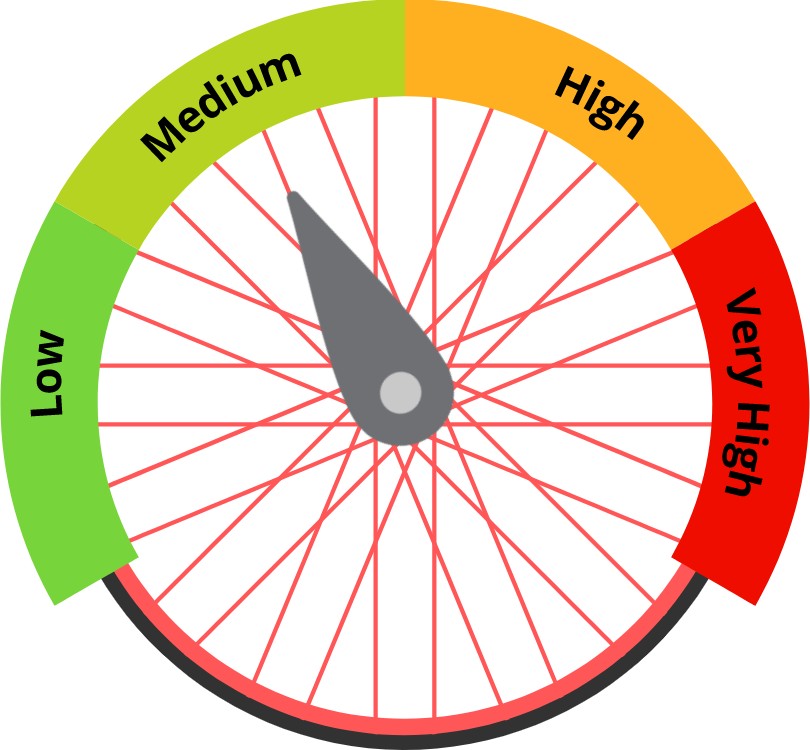
Mountain bike tire pressure is the most complex because of the number of variables, including tire widths (2.1″ – 2.8″), disciplines (XC, Trail, Enduro, DH), terrains, and MTB wheel sizes . In addition, individual preferences contribute heavily to mountain bike tire psi.
The gravity disciplines require higher PSI to maintain rolling speed and avoid flats when taking big hits. In contrast, a lower PSI may be favorable for enduro riding on loose terrain when grip is a priority.
Here a the MTB tire pressure ranges in terms of tire width:
- 2.1″ = 18 -26psi
- 2.25″ = 17 – 25psi
- 2.35″ = 16 – 31psi
- 2.4″ = 16 – 31psi
- 2.5″ = 15 – 30psi
- 2.6″ = 14 – 23psi
- 2.8″ = 14 – 22psi
Road Bike Tire Pressure
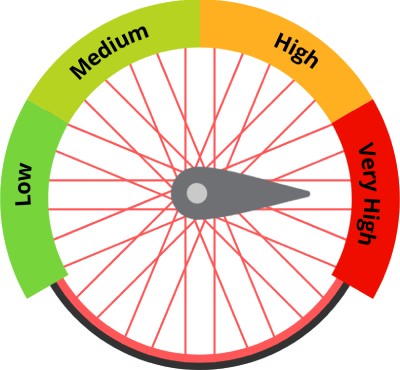
Road bike psi varies a lot in terms of the total number. As most roads aren’t perfectly smooth, a mid-to-low road bike tire pressure can improve speed because grip increases, vibration fatigue decreases, and momentum losses are lessened.
Additionally, run a lower bicycle tire PSI in wet weather to improve grip or very bumpy terrain (cobblestones) for comfort. However, don’t go below the recommended range, or pinch punctures occur.
- 23mm = 92 – 116psi
- 25mm = 80 – 104psi
- 28mm = 72 – 96psi
- 30mm = 63 – 84psi
Commuter Bike Tire Pressure

Commuter and hybrid bike tire pressure lies in the middle of the road and MTB ranges.
Rider preferences and terrain are the two primary considerations; performance is not significant for commuter or hybrid riders .
Because performance is less of an issue, you can allow more flexibility in the ranges. In addition, many commuters carry cargo requiring an extra 2-4psi per 10lbs of cargo .
Maintain a mid to high PSI for fast commutes on smooth city roads; experiment with the lower end of the range for mixed terrain and frequent wet weather.
- 35mm = 50 – 80psi
- 38mm = 40 – 70psi
Gravel Bike Tire Pressure
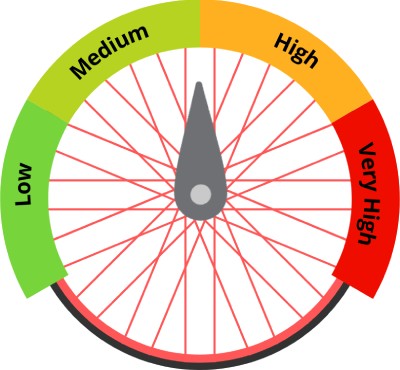
Gravel tires typically range from 35mm to 50mm in width. While the sizes are similar to hybrid bikes, gravel riders run lower psi to boost comfort and performance on rough terrain.
Experiment with a lower psi to find the gravel bicycle tire pressure for better rolling speed, grip, and comfort on heavy gravel paths and mountain trails. The higher end of the ranges should provide adequate comfort and grip, boosting rolling speed if you mainly ride light gravel paths and roads.
- 32-35mm = 30 – 48psi
- 38-42mm = 23 – 40psi
- 45-50mm = 19 – 33psi
Fat Bike Tire Pressure

Aside from cyclocross racing, fat biking encompasses the broadest range of surfaces, including soft terrains like mud, sand, and snow or harder terrains like mountain trails and gravel.
For soft terrain rides , it’s best to use a lower psi so you don’t get bogged down easily and can maintain grip. Conversely, on mixed terrain days or regular hardpack riding, increase the psi to reduce rolling resistance and improve speed.
- 3.8-4.0″ = 4 – 7psi
- 4.5-4.8″ = 3.5 – 6.5psi
- 5.0″ = 2.5 – 5.5psi
Kids’ Bike Tire Pressure
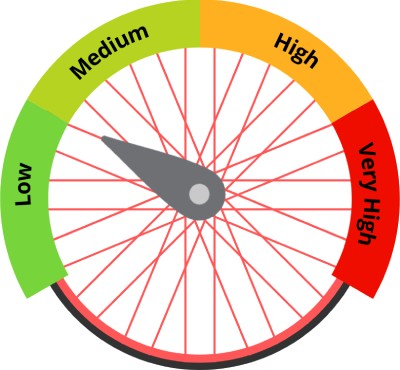
Kids’ tire pressure should always trend toward the low end of the range printed on the tire wall. The lower pressure is because kids’ are light, and they benefit from the added grip and comfort of a low psi, promoting enjoyable and confident riding.
For more experienced children and those riding just on pavement, raising the psi to reduce rolling resistance on smooth surfaces is acceptable. Kids’ wheel sizes and weight vary greatly, so take these estimates lightly and consult the manufacturer’s recommendations.
- Mountain bike = 18 – 36
- Hybrid bike = 30 – 60

Factors That Influence Ideal Bike Tire Pressure
Aside from performance factors, maintaining a minimum pressure ensures you don’t bottom out, and the tire bead doesn’t separate from the rim. However, if you go too low, you risk pinch punctures. Furthermore, don’t exceed the max pressure, or you may blow the tire.
Tire Size & Width

Tire size and width greatly influence how much pressure you should run. The wider the tire, the more air volume and less air pressure it requires.
The size and width of a tire change the total volume. The tire’s volume (how much air it holds) is the primary determinant of the psi.
H igher volume = lower psi.
From reading this article, you may have noticed the psi range decreases as the tire width increases. The same goes for larger diameter tires.
Manufacturer Recommendations
If you ever wonder, “what should bike tire pressure be?” each manufacturer prints a recommended bike tire psi on the sidewall. Always stay within the range provided to the abovementioned avoid issues when riding.
If you have old tires and don’t see the range, it may have worn off, so check the tire model on the manufacturer’s website. Place the pressure rating beside the valve for easier reference when installing new tires for quick reference.
>>>Related: Schwalbe Tires Review
Front vs. Rear Tire Weight Load
In general, 55-60% of a rider’s weight sits over the bike’s rear wheel. Use a slightly lower pressure (5%-10%) in the front tire to account for this.
Tubes vs. Tubeless
Tubeless tires are becoming increasingly popular across most disciplines, especially off-road ones (MTB and gravel). A sealant creates an airtight lock between the tire bead and the rim and ensures the valve stem is sealed and airtight.

Clincher vs Tubular vs Tubeless Tires — All Differences Explained
These tires don’t use an inner tube. As a result, they run at considerably lower psi without risking pinch punctures.
Bicycle and Rider Weight
When you sit on a bike, gravity causes the tire to compress. A heavier rider causes more compression, thus requiring more air pressure to counteract it. Adjust the psi higher or lower (within the manufacturer’s range) based on your weight.
Riding Conditions

The correct tire pressure depends on the terrain and surface. For optimal comfort and grip on rough terrain, make sure to decrease the tire pressure. Image: The Pros Closet
Different terrain and riding conditions require adjustments to psi. For example, for better comfort on rough terrain or traction in wet or muddy conditions, adjust the psi down. On the other hand, a higher psi will provide enough traction and comfort and potentially a speed boost on smooth terrain.
Finding the perfect psi for your typical routes and riding conditions takes experimentation.
Subjective Feel & Priorities
If you’re still asking yourself, “what should bike tire pressure be?” trial and error is the only way to find your preferred psi . Additionally, your preferences may change depending on the conditions, route, or how you’re feeling on the day.
Remember, the speed trade-off from lower psi is slight. If in doubt, err on the low end of your weight/manufacturer’s range and use a bike tire pressure calculator for an accurate calculation.
How to check bike tire pressure?
Connect your gauge to the valve by screwing on (Schrader) or pushing it down (Presta). It will then display a pressure reading. Use a needle-style gauge for the most accurate read.
How to put air in bike tires?
Use a pump or a CO2 inflator. Connect the head of the pump or inflator to the valve and either manually pump to inflate or twist a gas canister into the inflator which fills it automatically.
What is the proper tire pressure for a road bike?
The typical range for an adult road bike is between 60 to 120psi. See above for specific ranges based on road tire width.
What is the ideal tire pressure for a mountain bike?
The range for an adult MTB is 14 to 31psi. See above for specific ranges based on MTB tire width.
Bicycle Wheel Size Guide
Best Bicycle Tire Pumps
Best Fat Bike Tires
Share this on:
About the Author

Jordan Grimes

How to Achieve the Perfect Bike Tire Pressure
Our experts share how to find the right psi for your ride.
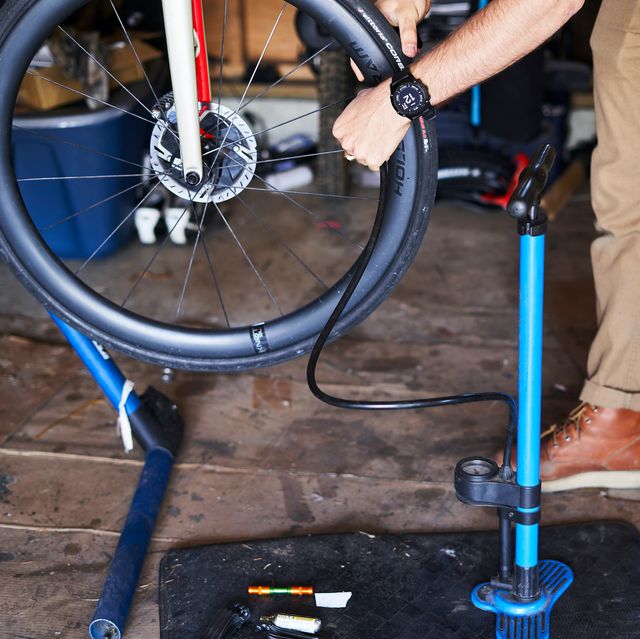
Gear-obsessed editors choose every product we review. We may earn commission if you buy from a link. How we test gear.
Check your bike tire pressure regularly.
Find the sweet spot., don’t overinflate., adjust according to tire volume., beware of the floor pump., play with different pressures..
It’s bike tire pressure. If you don’t pay attention to inflation, the amount of air in your tires is probably not only not ideal but wrong enough to cause excess flats and serious drop-offs in performance and comfort. Here are our experts’ top tips for finding the perfect bike tire pressure.
Pump it up.
Proper tire pressure lets your bike roll quickly, ride smoothly, and avoid flats . Narrow tires need more air pressure than wide ones: Road tires typically require 65 to 95 psi (pounds per square inch); mountain bike tires, 15 to 25 psi; and gravel tires, 25 to 40 psi.
In the past, to find your ideal pressure, we would recommend you start in the middle of these ranges, then factor in your body weight and experiment by going higher or lower until you find a pressure that works for you. But as research into tire pressure has ramped up with the advent of tubeless tires in the last few years, our knowledge of tire pressure has gotten more complex, and so have the formulas for getting to that magic pressure number. Today our recommendation is for you to skip the rule of thumb guessing game and go straight for a reputable tire pressure calculator. The two best options, that I've found, are calculators from Zipp and Silca.
Both of these calculators will ask you for some basic information such as your combined weight with your bike and gear, your measured tire width, wheel diameter, type of tire, and the surface you are riding on. Then they'll spit out a tire pressure recommendation based on your inputs.
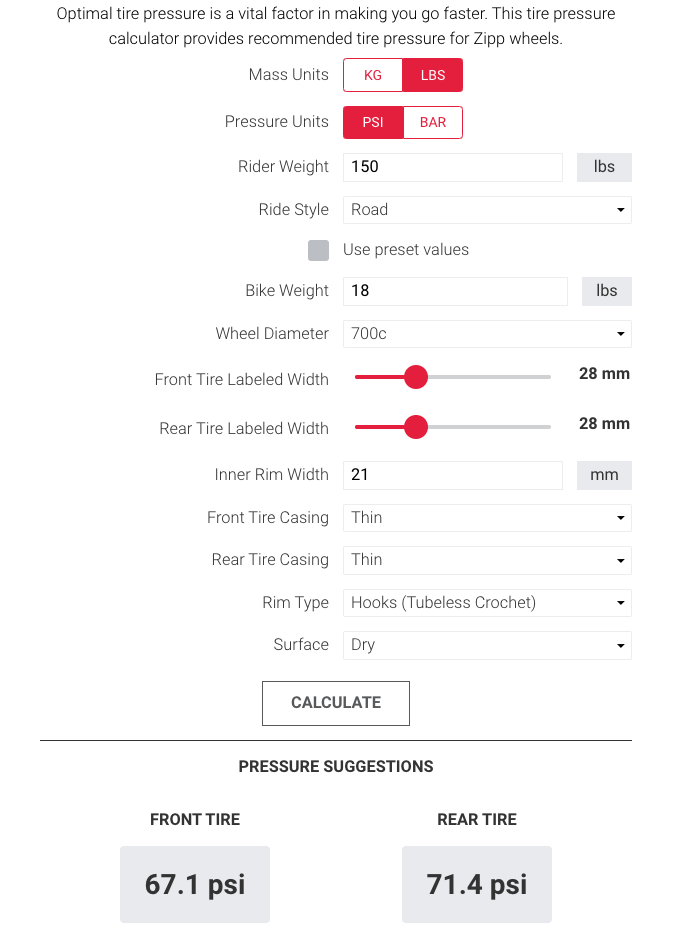
As you can see, each will deliver a slightly different pressure recommendation and for the most part, I would recommend splitting the difference between them for a good starting point.
Because both calculators ask for slightly different information, one might be more accurate to your situation than the other. For example, the Silca calculator allows you to very precisely select speed and surface conditions ranging from an indoor track all the way to Category 4 Gravel. The Zipp calculator, on the other hand, allows much more precise inputs for things like inner rim width as well as the type of rim you are using. Zipp's calculator generally gives a lower tire pressure recommendation (compared to Silca's) and has a specific option for hookless rims, which have much lower 72.5 psi maximum tire pressures than traditional hooked rims.
Never go above or below the manufacturer’s recommended tire pressures, which are listed on the sidewall as well as on the rims. If there is a discrepancy between the two, we recommend going with the lower number.
Tires leak air over time. A properly set up tubeless tire , and tires that use butyl tubes (the most common type), leak far less than lightweight latex tubes. But air seeps out of all tires, from as little as a few psi a week to drastic drops overnight. And the rate of loss increases with pressure and in reaction to outside factors like lower temperatures (about 2 percent vanishes for each 10-degree dip in Fahrenheit). Some of us at Bicycling check out tire pressure before every ride, some once a week. The important thing is to develop and stick to a habit of regular checkups and top-offs that works for you—if you don’t, your pressure is probably wrong most of the time you ride.
And always check the pressure the day after you repair a flat with CO2 canisters. Carbon dioxide is highly soluble in butyl rubber (nitrogen and oxygen, which make up 98 percent of our atmosphere, are far less so), so it basically permeates right through the tube wall, and fast. In fact, if you flat early on in a ride and fix it with CO2 , check the tire again after an hour or so—it will probably need topping off.
4 Pumps We Love
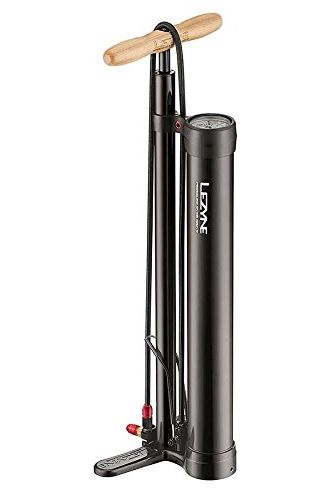
Lezyne Pressure Over Drive
Large air chamber seals tubeless tires quickly.
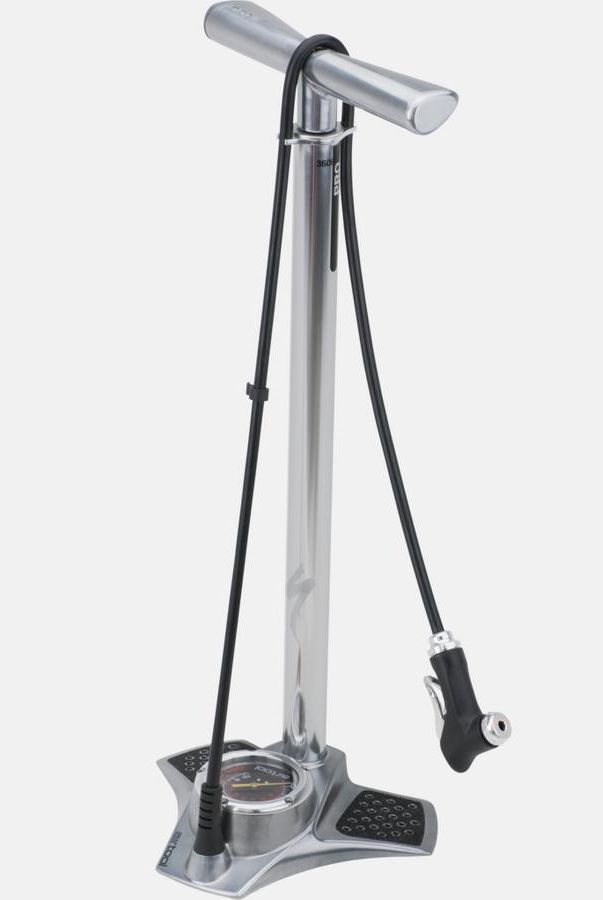
Specialized Air Tool Pro
A high performance floor pump with an all metal construction.
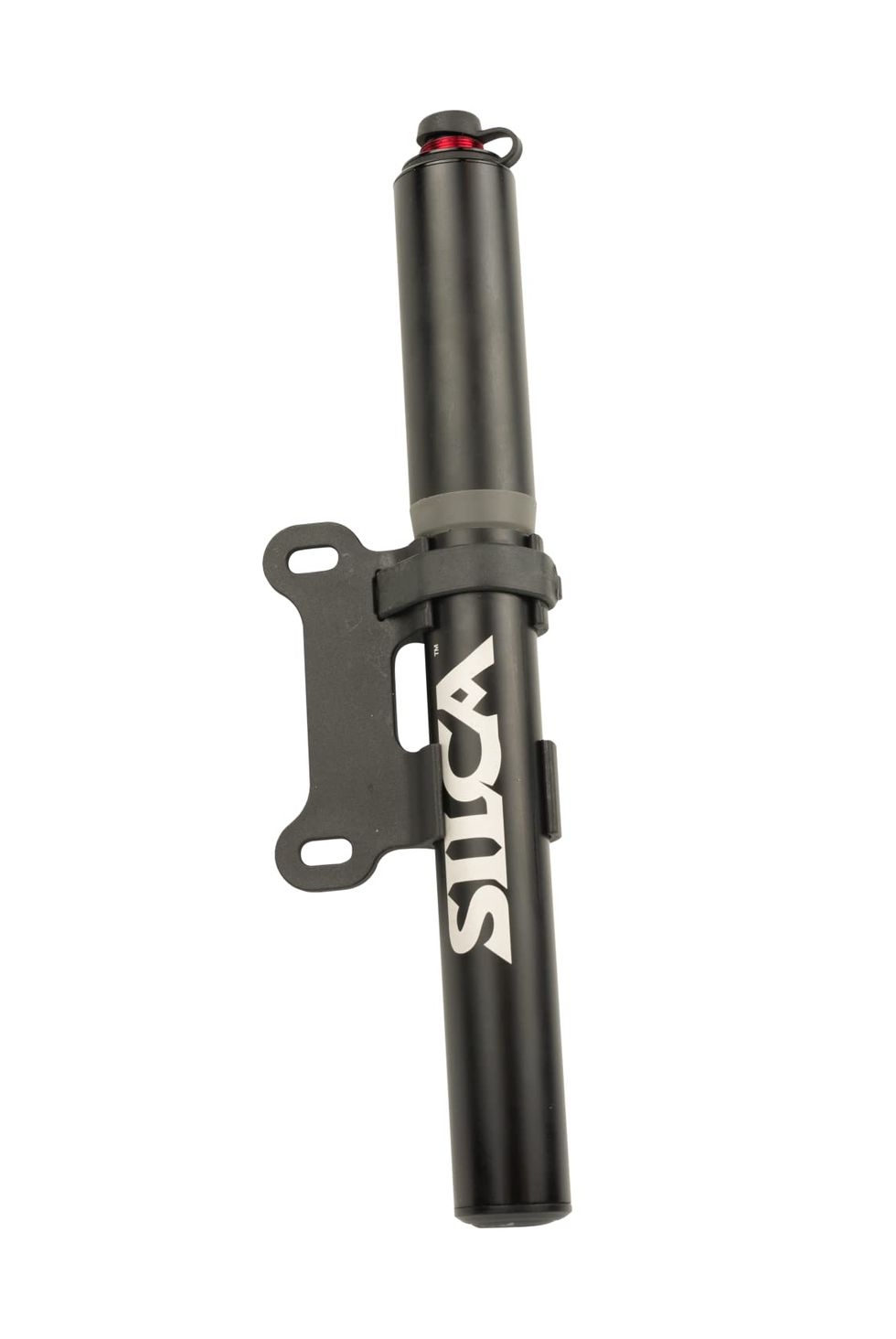
Silca Silca Gravelero Mini Pump
More air per stroke helps get tires pumped up faster.
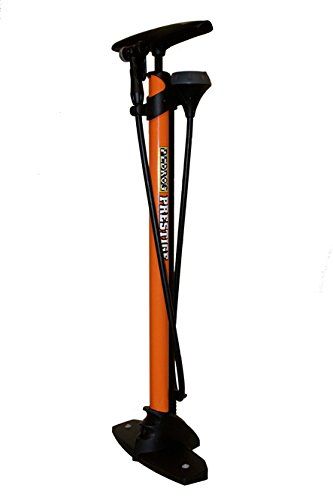
Pedro's Prestige Floor Pump
Steel construction, dual head, 160psi max.
Tire pressure isn’t a set-it-and-forget-it thing. Traditional wisdom says that higher tire pressure equals lower rolling resistance because, on a smooth surface, hard tires flex less and create a smaller contact patch. But no road is perfectly smooth. Properly inflated bike tires conform to bumps and absorb shocks. Overinflated bike tires transmit impacts to the rider, which sacrifices speed and riding comfort .
On new pavement, your tires might feel great at 100 psi, but on a rough road, they might roll faster at 90 psi. In wet conditions , you may want to run 5 - 10 psi less than usual for improved traction. And if you’re a mountain biker who rides to the trailhead, keep in mind that while your bike rolls smoothly on the road with 40 psi, it might feel better on the singletrack at 20 psi.
More isn’t always better. The general bias is almost always to overinflate. The maximum pressure listed on the sidewall is generally too high—plus, it doesn’t take into account any factors that influence your tire pressure, such as rider size and terrain. Especially if you’ve recently moved to wider tires, are about to embark on a ride full of corners and switchbacks, or ride surfaces like chip seal, you want to lower your pressure.
While rolling resistance does increase with lower pressure, several studies show that across various road tires, rolling resistance increases only slightly, on the order of a few watts of power , even at pressures down to 60 psi on standard road tires. Then, consider that rolling resistance makes up only a tiny fraction of the forces we have to overcome (most is either wind resistance or, on hills, gravity). The biggest differences in rolling resistance aren’t in pressure, but in the actual tire you’re using.
If you’re swapping from a traditional 23mm road clincher to 25mm or 28mm tires, or from a 2.1-inch mountain bike tire to a meatier 2.3-inch, you’re increasing tire volume significantly, so you have to adjust air pressure downward. Here are some sample bike tire pressure charts to consider.
If you’re inflating your tires with a floor pump , the gauge is probably not that accurate. Floor pump gauges measure pressure at the gauge, so they’re measuring air pressure inside the pump, not the tire. And gauge quality varies—it may be off by a few psi or as much as 10 to 15 psi.
The good news is that most gauges are at least consistent, even if they’re not totally accurate; so at least you’re inflating to the same pressure each time. The fix: Get a separate gauge. A needle-type Presta gauge is simple, affordable, accurate, and durable. Other brands also make low-psi versions (30 or 15 psi) for use with mountain, cyclocross, and gravel bikes for better accuracy. If ultimate accuracy is your goal, then consider investing in a digital gauge.
Tire Pressure Gauges We Love
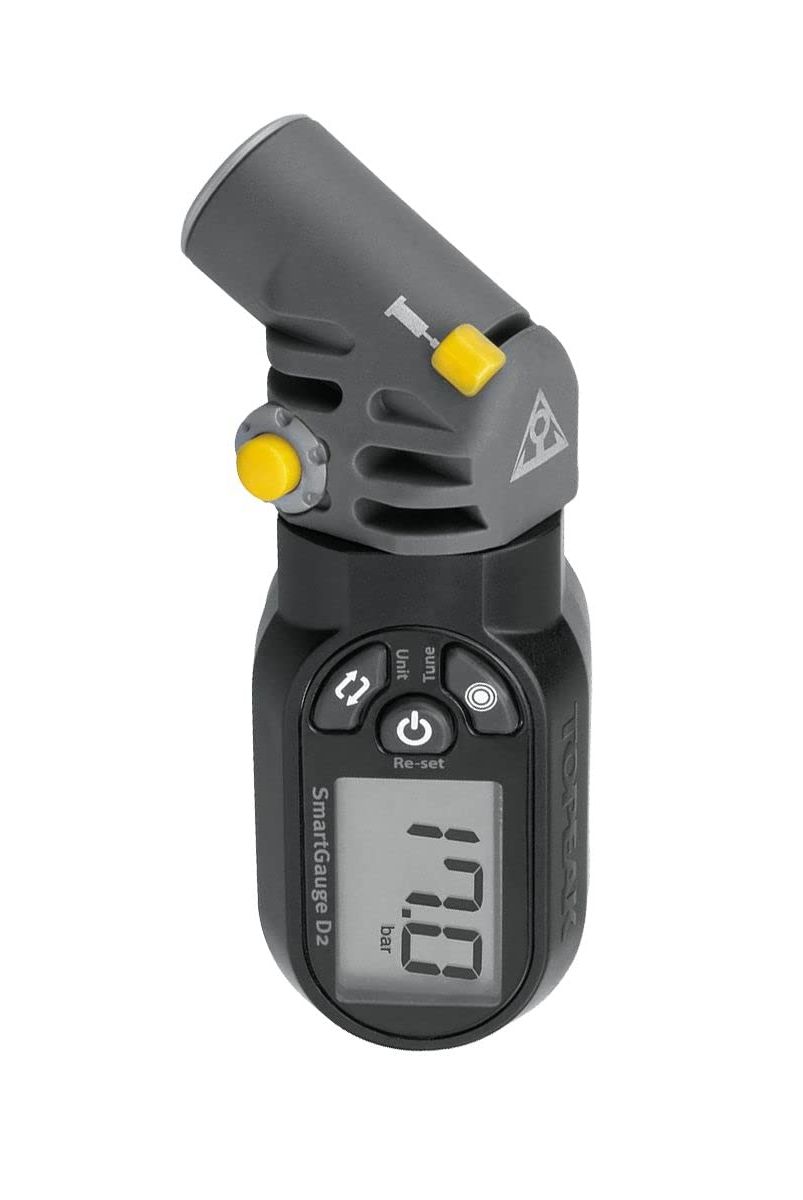
Topeak D2 SmartGauge
Consisten, reliable, and affordable.
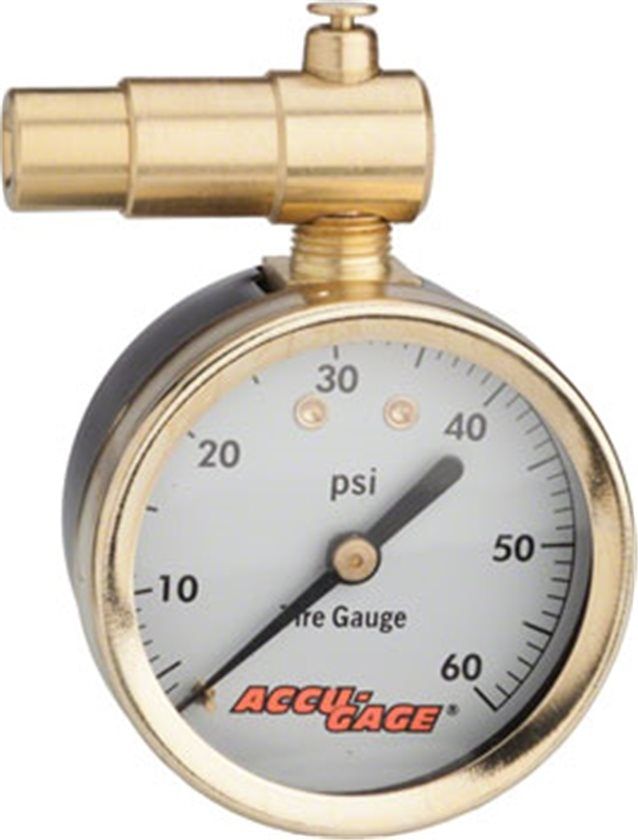
Meiser Accu-Gage Dial Pressure Gauge
For riders that prefer analog simplicity. Available in multiple ranges from 15 up to 160 psi
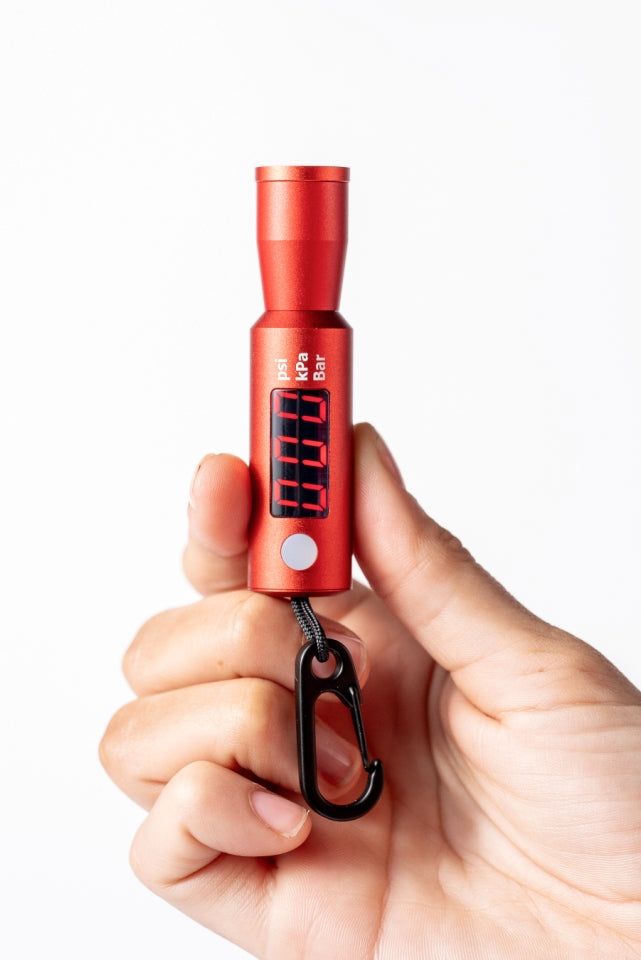
Fumpa Gauge
Incredibly compact and best for riders who want to experiment and make pressure adjustments out on the trail.
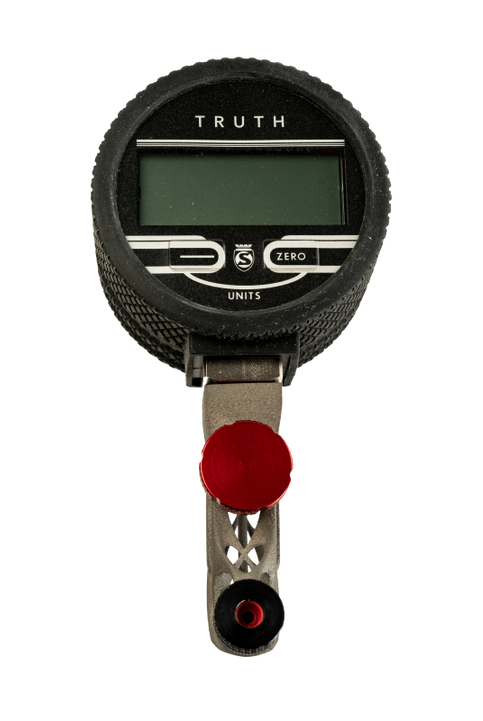
Silca Truth Gauge
For riders that care about absolute accuracy and don't care about the price.
It’s pretty common to simply inflate front and rear tires identically. But your weight balance isn’t 50-50 front to rear. For road riders, it’s more like 40 percent on the front and 60 percent on the rear in most cases, according to a study at the University of Colorado. But it can vary: the study found a range from 33-67 to 45-55 across the athletes they tested.
This means whatever pressure you prefer is going to depend on a variety of things, including your tire choice, type, and riding style, but it’s also clear that you shouldn’t run the same pressure front and rear. If you weigh 150 pounds with a 40-60 weight distribution, that’s 90 pounds on the back wheel and 60 on the front. So it stands to reason that you should be running proportionately less pressure up front. It won’t be 50 percent less, but it’s not unreasonable to think it could be 15 to 20 percent less.
Experiment with tire pressure by deflating front and rear, say, 5 percent each (percent, not PSI, because remember, front and rear are different and should be changed proportionately). Go ride and take note of how it feels, and don’t be afraid to drop a little more. Ideal tire pressure gives you a comfortable ride with a confident feeling in corners . Once the front wheel starts to feel the least bit squirmy in hard cornering, add a few psi back in. Measure front and rear with your gauge and write it down as a baseline, but remember—the perfect pressure may change according to conditions, terrain, weather, and if you switch tire sizes or brands.

Test Editor Dan Chabanov got his start in cycling as a New York City bike messenger but quickly found his way into road and cyclocross racing, competing in professional cyclocross races from 2009 to 2019 and winning a Master’s National Championship title in 2018. Prior to joining Bicycling in 2021, Dan worked as part of the race organization for the Red Hook Crit, as a coach with EnduranceWERX, as well as a freelance writer and photographer.
.css-1t6om3g:before{width:1.75rem;height:1.75rem;margin:0 0.625rem -0.125rem 0;content:'';display:inline-block;-webkit-background-size:1.25rem;background-size:1.25rem;background-color:#F8D811;color:#000;background-repeat:no-repeat;-webkit-background-position:center;background-position:center;}.loaded .css-1t6om3g:before{background-image:url(/_assets/design-tokens/bicycling/static/images/chevron-design-element.c42d609.svg);} Beginner Cycling
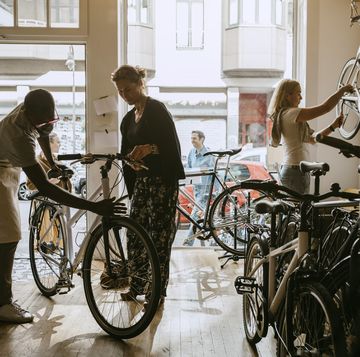
How to Corner on the Bike, According to a Pro
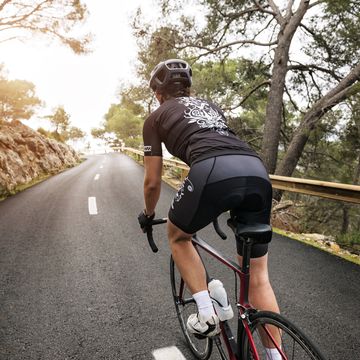
6 Tricks to Climb Better on Your Bike
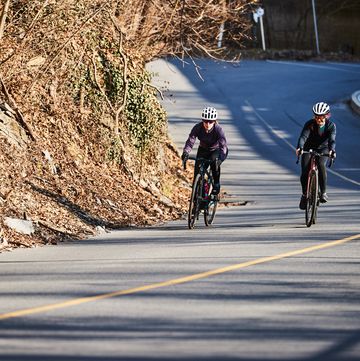
8 Road Bike Skills Every Rider Needs to Know
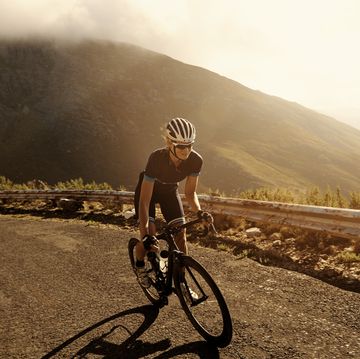
This Is Why You Need a Good Bike Fit
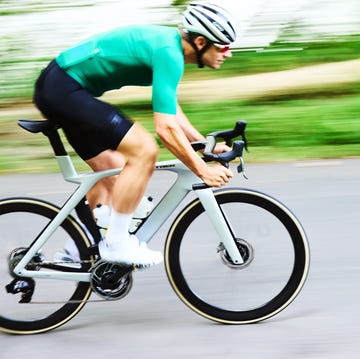
What Is the Average Cycling Speed?
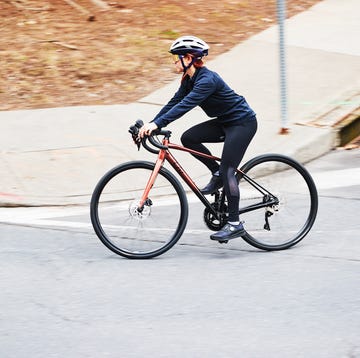
Make Riding More Fun With These Beginner Tips

6 Tips to Help You Crush Your Next Long Ride
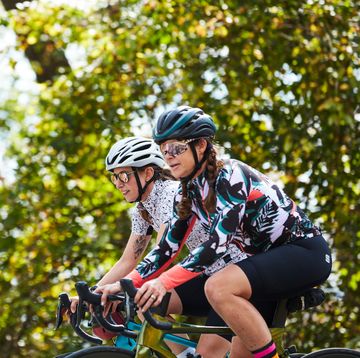
How to Become a Better Cyclist
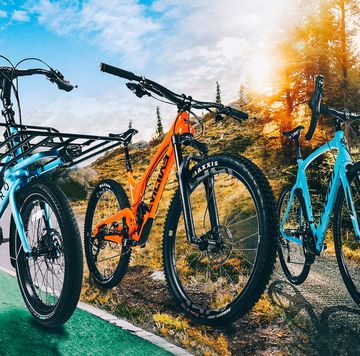
All of the Different Types of Bikes—Explained
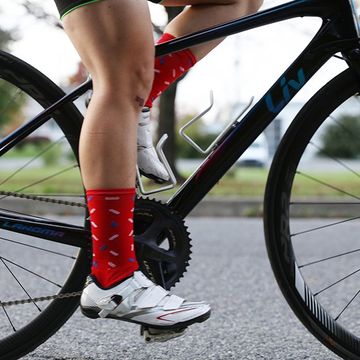
Does Ideal Cadence Really Exist?
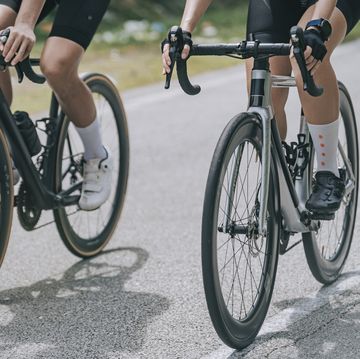
What to Know About Cycling for Weight Loss
Trek FX 2 Disc Equipped review: Unspectacular but effective
The trek fx 2 disc is a versatile all-rounder with surprising levels of comfort and stability.

Cyclingnews Verdict
Built around a frame with a superb balance between responsiveness and comfort, the Trek FX 2 Disc Equipped will tackle any task required of a hybrid bike in an effective, if unspectacular, manner
The frame has a great balance between responsiveness and comfort
Equipped for night riding, bikepacking or commuting
Can carry a decent amount of weight
Stable ride for long distances
Would need a drivetrain upgrade to become a serious fitness bike
On the heavy side for a rigid frame
You can trust Cyclingnews Our experts spend countless hours testing cycling tech and will always share honest, unbiased advice to help you choose. Find out more about how we test.
A hybrid bike can and will mean different things to different people. But sometimes it is simply the bike that fills the gaps, that doesn't do any one thing but in fact does it all. Purists may scoff and say to compromise is to ruin the essence of life: if you are not something, you are nothing. But Trek has offered a repost: if you can't be something, be everything.
That certainly appears to be the aim of the Trek FX 2 Disc Equipped. It's the jack-of-all-trades, odd-jobber of a bike. It comes, as the name suggests, fully loaded with a pannier rack, lights, mudguards and even a kickstand but what elevates it to a place among the best budget hybrid bikes available today is that, as part of Trek's fitness range, all that versatility does not come at the cost of all rideability.
And that's a crucial element. Just because a bike has more practical functions – going to the shops, commuting, family bike rides etc – doesn't mean it can't be fun, have its own personality and leave us looking forward to running that next errand.
Trek's FX range of bikes is quite extensive, starting at the £500.00/$599.99 FX 1 and going all the way to the full-carbon £3,050.00/$2,799.99 FX Sport 6. The FX 2 is available with a step-through frame – in both the Equipped and standard versions – and has been updated for 2023, with the main difference from the 2021 model being a move from a 3x8 to a 2x9 gearing system.
The FX 2 Disc Equipped is priced at £740.00 - it's not currently available in the USA - which is £90 more than the FX 2 Disc standard (£650.00/$799.99) which foregoes the rack, lights, mudguards and kickstand. Although it does come in a couple of extra colour options.
Design and specification
Recognising alloy frames' bad reputation for comfort compared to steel and carbon, Trek set itself a goal to "build more compliant frames that retain the acceleration and affordability that have always made aluminium popular" – and it is the fruit of that labour that the FX 2 Disc Equipped is designed around.
The Alpha Gold Aluminium frame, while not the lightest, does offer a great balance between responsiveness and comfort. It is also strong: according to Trek, the FX 2 Disc can take weights of up to 136kg (for bike, rider, and cargo combined), which fares well compared to other hybrid bikes in the same class such as the Merida Speeder 200 (120kg) and Scott Sub Cross 50 (128kg). The pannier rack that comes with it is also very solid and suitable for carrying loads up to 25kg despite weighing less than 600g itself.
My size large test bike as a whole weighed in at 13.4kg with pedals. The rack, lights, mudguards, and kickstand account for just over a kilogram of that weight but it's still a touch on the heavy side for a fixed-frame hybrid in this price range.
While the focus is on the practicality of the frame, it is by no means ugly – especially when stripped of all the accessories – with internal cable routing, a gentle curve to the top tube that is reminiscent of the Specialized Sirrus (one of the classic beauties of the hybrid world) and the choice of a striking Viper Red or classy Lithium grey colourway. The geometry is pretty much what you would expect from a hybrid, with perhaps a slightly longer chainstay length adding to its stability. It is not as upright as, say, the Sirrus but similar to the Cannondale Quick 3 – which is a good bike to use as a comparison in general.
Like the Quick 3, the Trek FX 2 comes with a Shimano Acera/Altus 2x9 drivetrain and has an integrated mounting system in the stem, as well as the ability to track cadence and other metrics using an integrated wireless sensor.
Trek's Blendr stem system is designed for easy installation of computers, lights and other accessories to your cockpit. It does, rather annoyingly, require an additional base to be purchased (which plugs into the stem) and then a further mount for the specific accessory (which attaches to the base) but that does allow for a wide range of options to suit all needs.
The DuoTrap S is a Bluetooth/ANT+ sensor that integrates into the chainstay and wirelessly transmits to a smartphone or computer to track cadence and other metrics. Again, it requires a separate purchase, but the frame is set up for it to be attached without the need for zip wires or other ungainly fasteners.
Trek has made an effort to include ergonomic grips on the FX 2 Disc Equipped, although they are a little on the basic side, especially compared to those on the more expensive models in the FX range.
The lights, however, are far more impressive, particularly the AXA Greenline 35 headlight. USB-charging, it has a wide beam, is also designed to be visible from the side and is discreetly mounted on the top of the fork, which avoids cluttering the cockpit.
The Tektro HD-R280 hydraulic disc brakes are pretty standard now for mid-range hybrids. My test bike came with Bontrager H2 Comp 700x32c tyres but with the mudguards fitted there is room for up to 35mm and Bontrager H2 Hard-Case Light 700x35c tyres are listed as an option on the spec sheet. Without the mudguards, Trek says the frame can accommodate tyres up to 38mm in width.
Performance
Trek deserves credit here for really delivering on its aim of a responsive-yet-compliant frame. It's one thing coming up with the jargon, but another bringing it to fruition at a genuinely affordable price. While the FX 2 Disc Equipped might come across as a bit of a plodder on paper, in reality, it has a surprising amount of responsiveness. Loaded up with a carry pack on top of the pannier rack, I was happy overtaking other cyclists on reasonably fast country roads, knowing I had the acceleration to get past and back across to the side of the road in ample time.
Yes, it's no speed demon – it doesn't have the playfulness of the Boardman URB 8.9 or the lightweight climbing ability of the Merida Speeder 200, two bikes at a similar price point – but where it completely outscores both is in comfort and stability, even with a rack, mudguards, light, kickstand all bolted on.
Interestingly enough, I took it for a ride with all those added extras stripped off and, while significantly lighter – making an obvious difference on climbs – there was not a huge noticeable change in its performance on the flat.
My test bike came with a slightly-different-to-advertised Microshift Marvo front derailleur instead of Acera T3000, which is roughly equivalent, and I had no issues with it. However, as a whole, I did find the drivetrain to be under-par for a fitness bike. It's perfectly functional and will get you pretty much wherever you need to go, but it is a little clunky and I noted that the next bike up in the FX range, the FX 3 Disc Equipped , comes with a 10-speed Shimano Deore groupset which, in my experience, is a huge step up in performance.
In particular, I could not get to grips with the drastic change when switching chainrings on the 46/30 chainset. If I didn't downshift on the 4th sprocket or earlier I found myself spinning out – and this is perhaps a rare example of the FX 2 Disc Equipped coming a little unstuck wanting to satisfy in all areas. That 16-tooth difference in the chainrings (the same difference as a 50/34 compact road chainset, for example) means the bike has the range to get up steep hills while also having enough gas on the flats, but the user experience is compromised a little in doing so.
Where it doesn't compromise, however, is in its comfort and handling, whether I took it on potholed roads, bike paths, or light gravel it felt so balanced and stable. I was even happy taking it on the grassy, rutted track of a nearby nature reserve – and this was all with the standard 32 mm tyres it came with. Even when there was a little rattling, you could tell it was coming from the rack, fenders, and lights rather than the frame.
Taking it out at night in light rain did little to change my faith in its dependability and the lights were superb, particularly the wide-beam fork-mounted headlamp – a marked improvement from the usual glorified-torch-on-the-handlebars setup I usually use. Neither front nor rear light offered an intermittent option but, having been driven to distraction on long night rides behind blinking bulbs in the past, that was no great loss to me.
I took the Trek FX 2 Disc Equipped on rides around the countryside, trips to the shops, rides with the kids, rides at night, in the rain, for exercise, for errands and more, and on every occasion, it delivered. It is solid and dependable without feeling clunky or cumbersome. It's not sexy but it's not ugly. It's not overly fun but it's no chore to ride.
It will do what it needs to do in almost every situation you will need a hybrid bike for. Not necessarily to the highest level, but to a high enough level that you won't feel like you are missing out.
Yes, I did find the Altus/Acera groupset to be restrictive in terms of performance but drivetrains can be upgraded, along with wheels and grips and seatposts etc. Having a top frame is such a great building block. I would stress, however, this frame still has a ceiling to what it can do as a fitness bike, even if it were upgraded in all those areas. It is built for sturdiness as much as anything else and the fact that its performance was similar with and without the rack, fenders, kickstand et al is quite telling. I'm not going to use it to take on the Brecon Beacons in the Dragon Ride but I might choose it over a more expensive performance-oriented bike for a long-distance overnight ride such as the Dunwich Dynamo , where comfort, stability and safety are the overriding priorities.
Tech specs: Trek FX 2 Disc Equipped
- Price Trek FX2 Disc Equipped : £740.00 / $N/A
- Price Trek FX2 Disc : £650.00 / $799.99
- Sizes : S, M, L, XL
- Weight : 13.4kg (actual, size L, with pedals)
- Frame : Alpha Gold Aluminium
- Fork : FX Alloy
- Shifters : Shimano Altus M2010, 9-speed
- Front derailleur : Microshift Marvo
- Rear derailleur : Shimano Altus M2000
- Crankset : 46/30
- Cassette : Shimano HG200, 11-36, 9-speed
- Brakes : Tektro HD-R280 hydraulic disc
- Wheels : Bontrager Connection
- Tyres : Bontrager H2 Comp, 700x32c
- Saddle : Bontrager Sport
- Seatpost : Bontrager Alloy, 12mm offset
- Stem : Bontrager Comp, Blendr Compatible, 7-degree, 90mm length
- Handlebars : Bontrager alloy, 31.8mm, 15mm rise
- Extras : Rack, Eurofender Snello mudguards, Spanninga SOLO rear light and AXA Greenline 35 headlight, Bontrager Satellite grips, kickstand

Thank you for reading 5 articles in the past 30 days*
Join now for unlimited access
Enjoy your first month for just £1 / $1 / €1
*Read any 5 articles for free in each 30-day period, this automatically resets
After your trial you will be billed £4.99 $7.99 €5.99 per month, cancel anytime. Or sign up for one year for just £49 $79 €59

Try your first month for just £1 / $1 / €1
Ben has been a sports journalist for 16 years, covering everything from park football to the Olympic Games. As well as cycling, his passions include podcasts, tennis and speaking enough Italian to get by on his snowboarding trips to the Dolomites. A DIY rider who is almost as happy in the toolbox as he is in the saddle, he is still trying to emulate the feelings he experienced as a nine-year-old on his first Peugeot racer – he couldn’t fathom the down-tube friction shifters then and he’s still wrestling with groupsets now. When he isn’t making a beeline for the nearest Chiltern hill, he is probably tinkering or teaching his kids how to clean a bike properly. He rides a heavily modified 1980 Peugeot PVN10 Super Competition (steel is real) when the road is smooth and dry, and a BMC Alpenchallenge when it’s not.
Wiggle and Chain Reaction websites set to be imminently relaunched by Frasers Group
Power to the People – A brief history of the power meter with Hunter Allen
'Even winning is possible' - Puck Pieterse dreams big ahead of Tour of Flanders debut
Most Popular
By Claire Sharpe February 06, 2024
By Josh Ross February 05, 2024
By Immy Sykes February 05, 2024
By Claire Sharpe February 02, 2024
By Immy Sykes February 02, 2024
By Josh Ross February 01, 2024
By Josh Ross January 31, 2024
By Will Jones January 30, 2024
By Immy Sykes January 29, 2024
By Josh Ross January 26, 2024
- off.road.cc
- Dealclincher
- Fantasy Cycling
Support road.cc
Like this site? Help us to make it better.
- Sportive and endurance bikes
- Gravel and adventure bikes
- Urban and hybrid bikes
- Touring bikes
- Cyclocross bikes
- Electric bikes
- Folding bikes
- Fixed & singlespeed bikes
- Children's bikes
- Time trial bikes
- Accessories - misc
- Computer mounts
- Bike bags & cases
- Bottle cages
- Child seats
- Lights - front
- Lights - rear
- Lights - sets
- Pumps & CO2 inflators
- Puncture kits
- Reflectives
- Smart watches
- Stands and racks
- Arm & leg warmers
- Base layers
- Gloves - full finger
- Gloves - mitts
- Jerseys - casual
- Jerseys - long sleeve
- Jerseys - short sleeve
- Shorts & 3/4s
- Tights & longs
- Bar tape & grips
- Bottom brackets
- Brake & gear cables
- Brake & STI levers
- Brake pads & spares
- Cassettes & freewheels
- Chainsets & chainrings
- Derailleurs - front
- Derailleurs - rear
- Gear levers & shifters
- Handlebars & extensions
- Inner tubes
- Quick releases & skewers
- Energy & recovery bars
- Energy & recovery drinks
- Energy & recovery gels
- Heart rate monitors
- Hydration products
- Hydration systems
- Indoor trainers
- Power measurement
- Skincare & embrocation
- Training - misc
- Cleaning products
- Lubrication
- Tools - multitools
- Tools - Portable
- Tools - workshop
- Books, Maps & DVDs
- Camping and outdoor equipment
- Gifts & misc
Correct tyre pressures for my trek FX 7.3 [700x32]?
Hi chaps, I am confused about what tyre pressures I need for front and rear, can anyone give me advice please and show me how to work pressures out and I would be very grateful, Thank you, I have the following information:
I weigh 15 stone 3 Ibs [97 Kg].
Bike weighs 3 stone [19 Kg].
Tyres are Continental 4 seasons 700 x 32.
I ride on Tarmac/cycle lanes.
Help us to fund our site
We’ve noticed you’re using an ad blocker. If you like road.cc, but you don’t like ads, please consider subscribing to the site to support us directly. As a subscriber you can read road.cc ad-free, from as little as £1.99.
If you don’t want to subscribe, please turn your ad blocker off. The revenue from adverts helps to fund our site.
Help us to bring you the best cycling content
If you’ve enjoyed this article, then please consider subscribing to road.cc from as little as £1.99. Our mission is to bring you all the news that’s relevant to you as a cyclist, independent reviews, impartial buying advice and more. Your subscription will help us to do more.
If you're new please join in and if you have questions pop them below and the forum regulars will answer as best we can.
Add new comment
10 comments.

- Log in or register to post comments
Really, it's not important. You'll know if they're too soft because when you go over bumps you'll feel the rims hit. Somewhere between 60 and 90 will work just fine. You can probably run 40 if you want a really squishy ride.
70-80 and don’t over think it....
Personally i’d Be happy with 50 given our crappy roads but I’d end up with too many punch punctures on the even ceappier pot hole bits.
Using mavic's calculator for a tube set up 73 psi / 5 bar all round ( it's a free app) but you can set up different parameters such as rim width which may affect the final choice.
For 32mm tyres and the weights you have given I'd begin with 90 PSI in the rear and 75~80 in the front. Adjust each in 10 psi steps until you are happy with how it feels.
If your gauge uses bar instead of PSI then try 6~6.5 rear, 5~5.5 front.
Please take any tyre advice with a pinch of salt, whether from the manufacturer (they have potential lawsuits to consider), a forumite or any kind of 'guru' or so-called expert.
Simon E wrote: For 32mm tyres and the weights you have given I'd begin with 90 PSI in the rear and 75~80 in the front. Adjust each in 10 psi steps until you are happy with how it feels. If your gauge uses bar instead of PSI then try 6~6.5 rear, 5~5.5 front. Please take any tyre advice with a pinch of salt, whether from the manufacturer (they have potential lawsuits to consider), a forumite or any kind of 'guru' or so-called expert.
For 32s that's way, way too high, I like my tyres pretty well inflated but suggesting starting with 90 for the rear is too much even with a 60/40 weight distribution, 75-80psi for the front is also well off! Have you actualy tried riding these pressures on that size tyre with that equivalent load, I have and it's bumpy as fuck on all but the very smoothest bits of tarmac, that's with compliant carbon flat bar, carbon fork and carbon seat stays and seatpost. Your equivalence to the pressures you are suggesting for 32s is like putting 136/110psi for 25mm tyres, bonkers!
Sure if you have a super smooth road for every single mile you have you could get away with that, but not for most roads you're going to experience in the UK, also you're wrong with suggesting adjusting 10PSI at a time, this is too big a step, you're likely to miss the sweetspot doing it that way, 5psi at a time at the very most.
There's a berto based calculator online somewhere.
I'm about your weight and ride a specialized globe pro as my daily( *) currently running 32r/28f, I usually stick about 80psi in each unloaded, if 32/32 then I'd go with 80psi rear and about 55 front and see how that feels, for some it might be too much and they want a softer ride, others maybe more.
If you're carrying circa 10kg loads in panniers regularly then I'd stick in another 5-7 at the back and maybe 2 track pump squirts at the front.
Your weight distribution on the FX will vary compared to a drop bar bike, more like 60/40 as opposed to 55/45.
* I'd recheck your FX weight as I doubt very much even with guards, a rack+ lights etc it'd be anywhere near 19kg, at least 5kg lighter even with pannier bags on board.
70psi. Now go ride your bike.
Ask your favourite search engine to look up "Frank Berto Tire Pressures" (he's a good guy from the USA), or trust this website: https://road.cc/content/feature/180830-how-choose-your-tyre-pressure-bal...
The graphs on this page may help - https://www.google.com/search?client=firefox-b-1-d&tbm=isch&q=continenta...
Latest Forum Topics
Operation journey - police provide bikecams to cyclists free of charge, drivers and their problems, fitting garmin cannondale varia rear view radar unit, car crashes into building - please post your local news stories, workouts - garmin - zwift - how, whats your favorite e-bike, wanted: cycling knickers, pictures of your bike, ebike rental in bled, latest comments.
I think the price is mostly academic, they won't be selling many (or any even), the price exists so they're technically "for sale" thereby not...
Just reading that gives me a bit of a headache. Which is probably very woke.
Really informative and thorough review. Thank you.
Over 30 years ago I was on a coach full of rugby players. We were in Edinburgh, and off to play a game before an international. Thr driver turned...
I didn't see that behind the class...
Punishment pass because middle of road.
Manslaughter is a genuine non-murder. But there's still a corpse.
The idea that barriers and restrictive bollards across cycleways are justified because of a tiny number of people riding illegal motorbikes is an...
Important for sentencing I assume. The driver stopped at the scene, rendered assistance, pled guilty, seemed to have shown genuine remorse and quit...

Custom Wheels in elektrostal,moscow oblast,russia
Custom wheels by brand.

Buy aftermarket custom rims, tires, accessories & more in elektrostal . Buy wheels in elektrostal,moscow oblast today and get fast worldwide shipping. Call 1-800-232-0734 . One of the first noticeable features on a vehicle is the wheels. The best part about changing your rims for a different look is that you don't have to modify your vehicle or spend hundreds or thousands to modify it. Search our site today to start the process of upgrading up your car, truck, or SUV. Not only do you get get the better aesthetics, but the value of your vehicle goes up as well.
On hubcap-tire-wheel.com you will find many wheel and tire packages, custom rims' brands like American Force wheels, Moto Metal wheels, Fuel wheels or 70+ other top of the line brands. See all of our wheel brands below and shop in elektrostal,moscow oblast,russia . To wrap those wheels we have a ton of different tire brands to select from. From Nitto tires to Nexen tires and everything in between.
Let our experts at Hubcap, Tire Wheel help find what you need to make your car, truck, Jeep or SUV stand out from all the other stock vehicles in elektrostal, moscow oblast . Give us a call at 1-800-232-0734 to let our experienced staff of over 100+ years of combined experience help you out today. There is no question too small or too big. We have you covered.
Once you've picked out your custom wheels and tires, take a look at our huge selection of truck and Jeep accessories. From soft tops to towing hitches, we've got you covered for all your truck accessory needs. We ship all truck and Jeep accessories to elektrostal, moscow oblast,russia so take a look and get what you need today.

- Custom Wheels
- Factory Wheels
- Instant Credit
- Testimonials
- Search By Vehicle
- Custom Wheel Buyers guide
- United States
- United Kingdown

IMAGES
VIDEO
COMMENTS
Stop pumping when you're within the range printed on the side of your tire. 10. Release the pump head by pressing the lever down and quickly pulling the head off the valve. If you're using a Presta valve, don't' forget to close it. 11. Secure your pump to the valve by pushing the pump head down on the valve as far as it can go.
Now some of this, we already know if you're on stock tires - they are 32mm and using tubes. If you're around 80kg (176lb), you might start with the max pressure on the rear tire as being around 70 psi, with the front tire about 10psi less. The idea that running tires at higher pressures will make them roll faster is objectively incorrect.
If you feel a burst of air, you're good to go. 6. Secure your pump to the valve by pushing the pump head down on the valve as far as it can go. Then, lock the head by lifting the lever. 7. Wiggle the head. If you feel the valve moving inside, it's not secure enough and needs to be pushed down even more. 8.
Name Size Pressure Range (psi/bar) AW1 Hard-Case Lite 700x23 90-125/6.2-8.6 AW1 Hard-Case Lite 700x25 90-125/6.2-8.6 ... Bontrager tire pressures Mountain continued. Name Size Pressure Range (psi/bar) Connection Hybrid 700x35 40-65/2.8-4.5 E6 Hard-Case Lite 700x50 40-80/2.7-5.5
If you feel a burst of air, you're ready to go. 6. Secure your pump to the valve by pushing the pump head down on the valve as far as it can go. Then, lock the head by lifting the lever. 7. Wiggle the head. If you feel the valve moving inside, it's not secure enough and needs to be pushed down even more. 8.
Some people prefer a 60/40 or 55/45 split, which means pumping the rear tire to a higher pressure than the front. This accounts for the greater weight that the rear of the bicycle has to bear. As well as rider and bike weight, any luggage or panniers you carry will increase recommended tire pressures.
FX 2 Disc is a stylish and versatile hybrid bike with disc brakes that let you stop on a dime and ask for change, even when the weather isn't cooperating. Train, commute, or ride for fun with the lightweight Alpha Gold Aluminum frame, 24 speeds, and semi-skinny tires that are fast on the road and stable on loose terrain. Compare.
Find the proper tire pressure range on your tire's sidewall. If you're inflating 26-inch tires (common on comfort and off-road bikes), you may find that the pressure range is wider, say "35 to 60 psi." This is because these tires can be used on and off road. For the former, 60 psi is about right because it rolls optimally on pavement.
Trek FX 2 Gravel Upgrades. One of the most popular questions in the bike shop these days is about gravel bikes. Its an awesome riding discipline that has exploded in popularity for good reason. An easy and affordable way to ride gravel is with the Trek FX 2. The maximum tire size recommended by Trek for the FX 2 Disc model is a 38mm tire.
Mountain bike tire pressure is the most complex because of the number of variables, including tire widths (2.1″ - 2.8″), disciplines (XC, Trail, Enduro, DH), terrains, and MTB wheel sizes.In addition, individual preferences contribute heavily to mountain bike tire psi. The gravity disciplines require higher PSI to maintain rolling speed and avoid flats when taking big hits.
Pump it up. Proper tire pressure lets your bike roll quickly, ride smoothly, and avoid flats. Narrow tires need more air pressure than wide ones: Road tires typically require 65 to 95 psi (pounds ...
Trek's FX range of bikes is quite extensive, starting at the £500.00/$599.99 FX 1 and going all the way to the full-carbon £3,050.00/$2,799.99 FX Sport 6.
38mm maximum tire size. Panaracer is a great on/off road tire. They make a 32, 35, and 38mm. Sounds like you need to add a dual-sport to your fleet, OP. I only just ordered the Trex FX 2 recently. The Goodyear County tires are my go to for mixed riding. What's the minimum spec for tire size?
Having a bike tire tube repair kit is essential and consists of spare tube, patch kit, tire levers, and a small pump. The best option is to carry a spare tube on every ride and replace the inner tube if it goes flat. If you don't have a spare tube, a bike tire patch kit is the next best option. Patching a bike tire tube will allow you to get ...
10. Hi chaps, I am confused about what tyre pressures I need for front and rear, can anyone give me advice please and show me how to work pressures out and I would be very grateful, Thank you, I have the following information: I weigh 15 stone 3 Ibs [97 Kg]. Bike weighs 3 stone [19 Kg]. Tyres are Continental 4 seasons 700 x 32.
Trek fx3 tire pressure? The side of the tire says 60-100 psi. But when I try to pump it, it's barely reaching 20psi and it's getting harder to pump. Feeling the tire it feels pretty full. How is anyone getting their psi that high? Your pump doesn't have a good seal on the tube.
Buy aftermarket custom rims, tires, accessories & more in elektrostal. Buy wheels in elektrostal, moscow oblast today and get fast shipping. 1-800-232-0734.
FX 2 is a versatile hybrid bike for fitness, commuting, or riding for the fun of it! It has a lightweight Alpha Gold Aluminum frame, 24 speeds and a wide range of gearing that's great in hilly terrain, and tires that are both fast on the road and stable on paths and loose terrain. Compare. Color / Matte Trek Black.
Today's and tonight's Noginsk, Moscow Oblast, Russia weather forecast, weather conditions and Doppler radar from The Weather Channel and Weather.com
Unless you average 30+km/h, go with the biggest, most performing tires your frame can get. The FX 2 seems to cap at 38s, I'd go for the René Herse Barlow Pass Extralight; you could also go with the Challenge Strada Bianca Pro in 36s or Gravelking slicks in 40s (they measure narrower). D1ngelhopper. • 2 yr. ago.
Elektrostal Weather Forecasts. Weather Underground provides local & long-range weather forecasts, weatherreports, maps & tropical weather conditions for the Elektrostal area.
The 9th radio centre of Moscow was a high power shortwave and medium wave broadcasting facility at Elektrostal near Moscow.Its broadcasting frequency was 873 kHz with a transmission power of up to 1200 kilowatts. It was also used as radio jammer of "unwanted" stations.